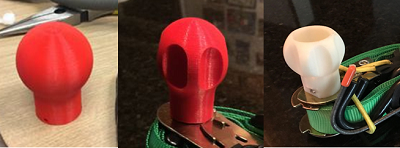Co-director of the Minnesota Center for Additive Manufacturing Associate
- FMA
- The Fabricator
- FABTECH
- Canadian Metalworking
Our Publications
Categories
- Additive Manufacturing
- Aluminum Welding
- Arc Welding
- Assembly and Joining
- Automation and Robotics
- Bending and Forming
- Consumables
- Cutting and Weld Prep
- Electric Vehicles
- En Español
- Finishing
- Hydroforming
- Laser Cutting
- Laser Welding
- Machining
- Manufacturing Software
- Materials Handling
- Metals/Materials
- Oxyfuel Cutting
- Plasma Cutting
- Power Tools
- Punching and Other Holemaking
- Roll Forming
- Safety
- Sawing
- Shearing
- Shop Management
- Testing and Measuring
- Tube and Pipe Fabrication
- Tube and Pipe Production
- Waterjet Cutting
Industry Directory
Webcasts
Podcasts
FAB 40
Advertise
Subscribe
Account Login
Search
Additive manufacturing frees designers’ creativity
3D printing lets inventor produce prototypes quickly and cheaply, and allows casting company to make gates faster
- By Kuldeep Agarwal
- January 23, 2019
- Article
- Additive Manufacturing

The inventor of the OmegaStrap had multiple iterations of his design 3D-printed for several hundred dollars.
Job shops involved in casting, sheet metal work, and machining typically aren’t contracted to perform long production runs. They are hired for small volumes of parts—those ranging from one to 1,000 pieces. With low volumes like these, though, it’s often too time-consuming and costly to make prototypes using traditional manufacturing processes.
In such cases, additive manufacturing (AM) often proves to be a good alternative.
Prototypes historically were produced by machining plastic or wood, a task that requires precise skills and access to a machine shop. All that’s needed today to make a dream product a reality is an AM service bureau and a computer-aided design drawing. Brad Willodson discovered the dream-fulfilling capability of AM prototyping when developing a plastic knob designed to improve the performance of ratchet-type tie-down straps.
An avid outdoorsman, Willodson was frustrated by how clumsy and difficult existing ratchet straps were to use. He designed a product, which he calls OmegaStrap, that attaches to a conventional strap’s cam-actuated securing mechanism. It reportedly eases the ratcheting action and helps prevent straps from tangling.
Willodson’s efforts led him to the Minnesota Center for Additive Manufacturing, Mankato, to design and prototype his idea.
After Willodson invested four months and paid the center a few hundred dollars to 3D-print samples, he had five different design iterations that fit existing ratchets. The inventor was able to adjust and tweak his design without investing in molds, thanks to AM. The positive outcome allowed Willodson to launch a Kickstarter campaign, and he expects to begin selling products soon.
Dotson Iron Castings also had a good outcome with AM. The Mankato company invested in an entry-level fused-deposition-modeling (FDM) printer and started making gating systems for its casting operation. A gating system like the one shown would take roughly 32 hours to cut from redboard (polyurethane) stock and mount on the match plate. A lot of time would be spent shaping the smaller features, such as the contact pad and riser neck, especially considering there are eight contact pads to machine (four in the cope and four in the drag). Dotson spent 50 hours printing the three components on its FDM system.
The layer thickness was 0.10 millimeter and the infill density was 40 percent. Additionally, the company chose a triangular infill pattern to enhance structural integrity during the molding process.
The main benefit the casting company has seen by 3D-printing gates is that it can produce components well in advance of machining the match plates. When in-house shop personnel cut the gating components, they had to wait to receive the pattern to ensure the components fit together properly. With 3D printing, shop personnel can have the components ready to mount to the match plate as soon as they receive it from the pattern shop. The resultant time savings has allowed Dotson to get first-time samples scheduled, molded, and poured more quickly than was possible previously.
These are just two examples of how AM can be used to meet a variety of prototyping needs. Success with AM requires a little creativity and, perhaps most importantly, being receptive to trying the technology.
About the Author

Kuldeep Agarwal
507-389-6157
About the Publication
- Podcasting
- Podcast:
- The Fabricator Podcast
- Published:
- 05/07/2024
- Running Time:
- 67:38
Patrick Brunken, VP of Addison Machine Engineering, joins The Fabricator Podcast to talk about the tube and pipe...
- Trending Articles
- Industry Events
World-Class Roll Forming Workshop
- June 5 - 6, 2024
- Louisville, KY
Advanced Laser Application Workshop
- June 25 - 27, 2024
- Novi, MI
Precision Press Brake Certificate Course
- July 31 - August 1, 2024
- Elgin,



























